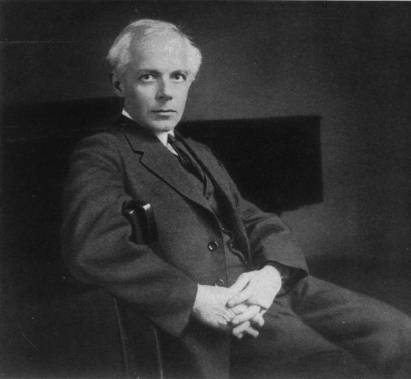Béla Bartók (1881-1945) was a Hungarian composer, pianist, and ethnomusicologist, and is considered one of the most important and influential composers of the 20th century. In the first of an occasional series, we offer five things to listen for in his Suite, Op. 14.
In the first of an occasional series, we offer Five Things to listen for in Béla Bartók’s Suite, Op. 14.
Béla Bartók (1881-1945) was a Hungarian composer, pianist, and ethnomusicologist, and is considered one of the most important and influential composers of the 20th century. He is best known for his innovative approach to composition, which drew heavily on folk music, as well as his contributions to the development of modern music.
Bartók's music is characterized by its use of dissonance, complex rhythms, and unusual scales and modes, and his works often explore themes of Hungarian nationalism and folklore.
In addition to his compositional work, Bartók was also a pioneering ethnomusicologist, and his field recordings of folk music from Hungary, Romania and other parts of Eastern Europe are considered some of the most important recordings of their kind. He incorporated many of these folk music elements into his own compositions, helping to create a distinctive style of classical music.

Overall, Bartók's innovative approach to composition, his exploration of folk music, and his contributions to the development of modern music have made him one of the most significant figures in the history of classical music.
Bartók's most famous works include his ballet "The Miraculous Mandarin," his Concerto for Orchestra and his six string quartets. He was also a prolific composer of piano music, including his Sonata for Piano and Suite, Op. 14, the latter of which is a significant work in his early output and is considered a key piece in the development of his unique compositional style.
Written in 1916, the Suite is a collection of four short pieces that range in character and mood, from the playful and energetic "Allegretto" to the slow and introspective "Sostenuto." The suite is notable for its use of irregular and asymmetrical rhythms, and for showcasing Bartók's developing interest in folk music. Benjamin Suchoff writes that it, “reflects Bartok’s treatment of the piano essentially as a percussion instrument, rather than its previous romantic notion purely as a stringed instrument.”
Reflecting upon a 1944 radio interview of Bartók, scholar David Yeomans writes in “Bartók for Piano: A Survey of His Solo Literature,” that this work highlights a new trend of piano writing:
“In it he sought to refine piano technique into a simpler and more transparent style and to avoid the excesses of his earlier post-Romantic piano writing. Although the Suite is the only work produced during the period 1914-1917 that is not based on original folk melodies, there is an unmistakable similarity to folk materials in some of the movements, especially of Romanian (No. 1) and Arabic (No. 3) origins. Much experimentation with whole-tone and other scale patterns, and one can even find a twelve-tone row in No. 2, probably the only instance in Bartók’s entire piano writing.”
Here are five things to listen for in this piece:
- Folk music influences: Bartók was known for incorporating Hungarian folk music into his compositions, and this suite is no exception. Listen for the use of folk rhythms, melodies, and harmonies throughout the piece, particularly in the first and third movements.
- Dissonant harmonies: Bartók's music is known for its use of dissonant harmonies, which are built from combining notes that are less harmonically related and create a sense of tension and complexity. Listen for moments where the harmonies are particularly dissonant or where the tonality is difficult to identify.
- Unconventional piano techniques: Bartók used unconventional piano techniques to create unique sound effects and textures. Listen for when he uses the piano pedal to create a blurred or resonant effect and how some sections extract maximum effect of the piano’s hammer-striking mechanism, making it a more of percussive instrument than a singing stringed instrument adored by earlier composers.
- Rhythmic complexity: Bartók's music often features irregular rhythms and complex syncopations and Op. 14 is no exception. Listen for moments where the meter changes abruptly or where the rhythm is difficult to predict.
- Dynamic range: Bartók's music can be very dynamic, with sudden shifts in volume and intensity. He often juxtaposes sections that are quiet and introspective with sections that are loud and aggressive, creating a sense of tension and release throughout the piece.
American Pianists Awards finalist Mackenzie Melemed performed Béla Bartók’s Suite, Op. 14 during the 2021 Awards.
The four movements of this piece are as follows:
- 00:00 - Allegretto
- 02:10 - Scherzo
- 04:08 - Allegro molto
- 06:15 - Sostenuto
Overall, Béla Bartók's Suite, Op. 14 represents an important milestone in the composer's development and is significant for its incorporation of folk music elements, unconventional forms, innovative harmonies, and personal significance. It is considered one of Bartók's most important early works for solo piano. Listening for these elements, one can gain a deeper appreciation for Bartók's innovative style and his unique contributions to the world of classical music.
---
"5 Things to Listen For" is an occasional music appreciation series that highlights remarkable compositions performed in the American Pianists Awards. The Awards are held every two years and alternate between jazz and classical piano. Find more music on the jazz media and classical media sections of this site. Look for live performances by past winners on our calendar. And subscribe to our free monthly newsletter.
